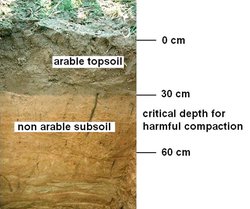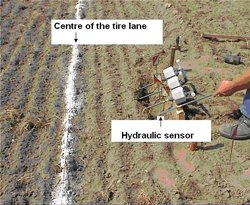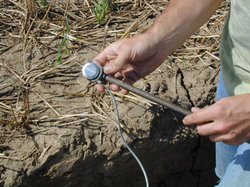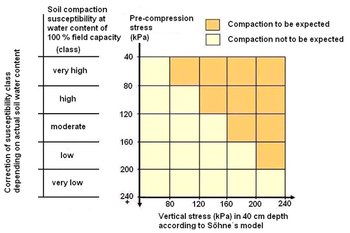Soil compaction
| Topics: |
Contents
- 1 Abstract
- 2 Introduction
- 3 Ecological and environmental consequences of soil compaction
- 4 Governmental strategies against soil compaction
- 5 Recommendations in practice
- 6 Soil physical approaches
- 7 Indicators for harmful soil compaction
- 8 Indicator set for the protection of soils against harmful compaction
- 9 Conclusions
- 10 Further Reading
Abstract
Soil compaction in agriculture and forestry is of growing concern. Heavy wheel loads have the potential to impair soil health by soil compaction. In order to maintain soil functions on a sustainable basis, strategies against further compaction are necessary. Technical solutions of best management practices in agriculture have been developed to minimize soil compaction. But they may not be sufficient to safeguard against damage to soil structure, since they do not compare the compressive forces of farm implements with the soils physical resistance against compaction. The effectiveness of practical means against soil compaction needs to be validated by physical soil assessment methods. Soil mechanical research has developed models to predict soil stress propagation below a running tire. Stress sensors have been developed to validate model predictions. Soil physical research has identified the parameters that characterize soil bearing capacity during wheeling. With the help of a bearing capacity model it is possible to assess, for given loading conditions, whether soil compaction in the subsoil will occur. If soil compaction is likely to occur, indicators are needed to assess harmful changes in the soil structure. Soil physical research has identified soil parameters that indicate harmful soil compaction and proposed an indicator set for the protection of soils against compaction integrating practical, mechanical, and soil physical aspects into one unique strategy.
Introduction
Soil compaction is understood as an increase of the state of compactness of a soil (Soil compaction) . The soil structure is made up by a skeleton of solid particles with different particle size varying from the coarse sandy to the fine clayey fraction. Between the solid particles are pore spaces that also vary in size and shape. The pore space is filled with air and water. It regulates the air and water regimes in soils. It conducts and stores water and air and it provides the channels for roots penetrating the soil. Soil compaction reduces the pore space and considerably impairs the properties of conductivity, storage and rootability. Compaction can be induced by natural processes as the transmission of clay perpendicular within the soil profile or by glacial pressure during the ice age or by human impacts as the pressure resulting from heavy machinery in agriculture and forestry. The latter is actually of growing ecological concern, because the weights of machinery have been steadily grown in the past. The wheel loads of heavy machinery can reach 15 Mg in agriculture and 12 Mg in forestry. Soil compaction may have negative consequences for the productivity and the functionality of soils. Experts estimate, that about 32% of the subsoils in Europe are highly susceptible and another 18% show moderate vulnerability to compaction. In agriculture especially subsoil compaction could become a severe long term threat to soil productivity and soil health. For that reason human induced soil compaction should be watched and analyzed in order to set up strategies to reduce or better to avoid it.
Ecological and environmental consequences of soil compaction

Soil compaction directly affects soil functions related to the productivity of soils. It has an impact on water and air storage capacity, oxygen supply to roots, and rootability. These properties influence plant growth and yield capacity. But also soil functions related to the environment, e.g. soil air and water conductivity, and heat balance are affected. Reduced water storage capacity and water conductivity can support flooding after heavy rainfall. The reduced infiltration capacity may lead to a higher erosion susceptibility. Soil compaction induces changes in nutrient cycles, due to altered soil chemistry and greenhouse gas emissions can be elevated, due to alterations of the air regime of a soil. Since soil structure influences nearly all processes in the soil, compaction directly or indirectly affects the whole range of soil functions.
The critical depth for harmful soil compaction in agricultural soils is the subsoil layer below the arable topsoil. In ploughed [[soil]s] it is located in a depth of about 30 – 60 cm (Fig. 1).
Governmental strategies against soil compaction
The governments and administrations in several countries recently started to react on the problem of soil compaction. The European Union funded a “Concerted Action Soil Compaction” to summarize the actual state of research and knowledge in that field. The European Commission proposed to initiate a framework of a directive for a European soil protection strategy in order to standardize the goals and procedures for the protection of soil functions affected among others by compaction. In the German Federal Soil Protection Act farmers are required to take precautionary measures against compaction specified in the code of good farming practice. Also several other countries in the European Union have established national soil legislation.
Recommendations in practice
Practical recommendations for precautions have been proposed as means of best management practice:
- Reduction of stresses (e.g. enlarged tire width, reduced machine weight or reduced bunker filling under wet soil conditions)
- Improvement of soil stability (e.g. by reduced tillage, no tillage or conservation tillage)
- Further development of techniques (e.g. regulation of tire inflation pressure, low-pressure tires)
- Adaptation of farming procedures (e.g. the adaptation of row width to enlarged tire width)
The competent agricultural advisory bodies together with the farmer determine the required level of action on site. General principles for best management practices are suitable to minimize soil compaction. Since they do not compare actual stresses in the subsoil induced by farm implements with the mechanical resistance of the soil against compaction, they are not suitable to solely avoid soil compaction. The effects of practical means against soil compaction need to be validated by physical soil assessment methods.
Soil physical approaches
International research has clearly identified soil vehicle data and the physical principles of soil stress transmission as essential for the compressive stresses reaching the subsoil. Soil stability and soil strength are the main factors influencing the bearing capacity of [[soil]s] that is understood as the internal resistance of a soil against deformation. The knowledge of soil stresses and bearing capacity is essential for the physical based assessment of the mechanical soil behavior under external loading.
Assessment of soil stresses

Stresses acting within the soil can be modeled according to Boussinesq’s theory of the distribution of stresses in elastic, homogeneous and isotropic media under a surface point load. Taking into account that soil strength is often not isotropically and homogeneously distributed and that the soil is not a fully elastic medium, the theory was completed by a concentration factor (vk). Under firm soil conditions the stresses transmitted down the soil profile are less concentrated around the perpendicular line than under soft soil conditions. Söhne modified the model for calculations of isobars of the vertical stress below agricultural tires (Fig. 2), considering that the tire print is elliptical. As input parameters the wheel load, the contact area of the tire, the contact area pressure and a concentration factor vk are needed.
For the validation of model calculations and for the adjustment of concentration factors different types of stress sensors have been developed. Hydraulic sensors consist of a flexible tube at the tip that is filled with a liquid. The sensor is installed diagonal from the soil surface under the center of the tire lane in the desired depth (Fig. 3). The pressure of the liquid under wheeling is indicated by a pressure gauge. Sensors of that type indicate an average normal stress that has no direction in the soil. They are useful for a quick and coarse comparison of the stress situation in the soil under different loading conditions.

For the validation of a directed, vertical stress pressure gauges with an elastic membrane are needed (Fig. 4). With strain gauges on the internal side of the membrane directed stresses can be indicated and registered electronically. With an arrangement of three orthogonal and three octahedral transducers, the complete stress state in a soil can be registered and principle stresses, normal and shear stresses and stress invariants can be calculated. The installation of directed transducers takes more expense than that of a hydraulic sensor, because it is installed horizontally into the soil.
Assessment of bearing capacity
For the assessment of the reaction of a soil on stresses, criteria are needed that indicate strain. A criterion that indicates whether an irreversible, semi elastic soil deformation is likely to occur is the bearing capacity of a soil. A common means to quantify the bearing capacity for normal, vertical stresses of foundations is the pre-compression stress. The pre-compression stress is determined by the confined compression test of undisturbed soil cores. The graphical procedure of Casagrande constructs a connecting point of the recompression (RCL) with the virgin compression line (VCL) that defines the pre-compression stress (Fig. 5).
Soil physicists proposed the use of the pre-compression stress for the assessment of bearing capacity of agricultural and forest soils compared to the normal, vertical component of soil stresses in order to prevent soils from compaction. The basis of the concept is assessment of the soil compaction process by comparing the pre-compression stress of a soil at given water content with the calculated vertical stress in a certain soil depth. As long as the pre-compression stress is higher or equal to the vertical stress component, induced by a vehicle in the corresponding soil depth, no additional compaction is to be expected. The process of additional compaction is initiated when the vertical stress exceeds the pre-compression stress. The vertical stress is determined according to the model of Söhne (Fig. 2).

An example for the use of the pre-compression stress model in agriculture to protect subsoils against compaction is given in Figure 6. On the stress-axis the normal, vertical stress in 40 cm depth caused by a vehicle is calculated according to the Söhne model. On the bearing capacity axis, the pre-compression stress at the high water content of field capacity is given. For lower water contents the class of susceptibility must be corrected. The classes of soil susceptibility towards compaction in dependency of the water content can be taken from tables offered by national soil surveys. At a given vertical stress by a vehicle and susceptibility class of the soil, it can be concluded from Figure 6, whether subsoil compaction is to be expected or not.
Indicators for harmful soil compaction
|
Table 1: Soil functions affected by soil compaction and soil parameters as possible indicators. | ||
|
Soil function |
Single Indicators |
Aggregated Indicator |
|
Air storage |
Air capacity |
For all functions: Visual classification of packing density |
|
Air flow |
Air permeability | |
|
Water storage |
Available water capacity | |
|
Water flow |
Water conductivity | |
|
Rootability |
Root length density | |
The assessment of soil compaction by a bearing capacity model shows if compaction is likely to occur or not. If compaction occurs, the bearing capacity model does not prevent information about the extent of compaction. Models that predict the change of soil structure due to compaction are scarce. Some analytical and numerical models that work on a high sophisticated level have been introduced. But, these models are not satisfactory prepared and evaluated for a simplified use in soil protection up to now. To effectively identify harmful changes to the soil through loading, soil properties have to be analyzed, that are directly affected by soil compaction. These are the soil physical properties of the air and water regime and parameters indicating rootability (Tab. 1). Soil physicists have verified the parameters as possible indicators with regard to their suitability for an efficient identification of harmful soil compaction. Indicators must be clearly defined, must distinctly show the process of compaction, must have a standardized analysis and must have thresholds to distinct between good and harmful soil conditions. As a result only three parameters are especially qualified as suitable for indicating detrimental effects in the subsoil: the soil’s physical properties of air capacity and saturated water conductivity, and the method of visual valuation of the packing density. For these parameters, threshold values for harmful soil compaction can be derived (Tab. 2).
|
Table 2: Parameters and thresholds for the identification of harmful soil compaction. | |
|
Parameter |
Limit for harmful soil conditions |
|
Air capacity |
< 5% (vol.) |
|
Saturated water conductivity |
< 10 cm d-1 |
|
Visual classification of packing density |
Classes 4 and 5 |
At values smaller than 5% (vol.) for the air capacity, a reduction of oxygen pressure in soil air and an impairment of root growth are reported for Western European soils. Values smaller than 10 cm d-1 for the saturated hydraulic conductivity, are indicators for stagnic horizons in Western European soils. The threshold values depend on the respective climate conditions. Methods for visual classification of soil morphology have been worked out in several countries by the National Soil Surveys. The one referred to in Table 2 classifies the soil according to its level of compactness into 5 classes from 1 (very loose structure) to 5 (very dense structure). The classes 4 and 5 indicate soil compaction and a disruption of soil functions.
The vast variability of [[soil]s] and soil conditions does not allow for identification of harmful soil compaction based on a sole parameter. A distinct detection is only possible when all three parameters exceed the thresholds for harmful soil compaction at the same time: the air capacity is less than 5% (vol.), the saturated water conductivity is below 10 cm d-1, and the soil is classified into classes 4 (= dense) or 5 (= very dense) by the visual soil structure valuation method.
Indicator set for the protection of soils against harmful compaction
|
Table 3: Four steps for the assessment and avoidance of harmful soil compaction by a combination of soil physical approaches, practical recommendations and indicators for impairment of soil functions. (Source: Lebert and Böken, 2004) | |||
|
|
|
|
|
|
|
Determination of the compaction impacts of farming techniques by a bearing capacity concept using the pre-compression stress (Fig. 6) |
a) No additional |
No further measures required |
|
b) Additional |
Step 2 | ||
|
2 |
Optimization of the loading conditions according to the recommendations for best management practice |
Step 3 | |
|
3 |
Repetition of step 1 with respect to the optimized loading conditions |
a) No additional |
No further measures required |
|
b) Additional |
Step 4 | ||
|
4 |
Soil structural analysis to assess harmfulness of soil compaction according to the parameters and thresholds of Table 2:
|
a) Soil structure in |
No direct measures required; Repetition of analysis periodically |
|
b) Soil structure |
Measures against harmful soil compaction | ||
|
c) Soil structure in |
Measures for remediation | ||
Soil scientists proposed a procedure of four steps to assess the risk of harmful soil compaction and to derive requirements for preventing it that provides a combination of the above-described soil physical concepts and aspects and links them to the practical recommendations for best practice management (Tab. 3).
In the first step, farming techniques that induce the process of compaction by exceeding the soil stability and strength will be identified with the aid of a concept that compares soil stresses with a means for bearing capacity.
In the second step, for these techniques the soil stresses will be reduced as far as possible as proposed by the recommendations for good farming practice.
In the third step, the bearing capacity concept is applied again, to indicate whether the modified loading conditions with reduced soil stresses are suitable for the avoidance of subsoil compaction. If so, no further measures would be required and the efforts of precautions would have been successful. If not, a fourth step for averting harmful subsoil compaction would be required.
In this fourth step, the parameters indicating harmful soil compaction are determined by analysis of the subsoil of the concerned fields. If the soil structure is in good condition compared with the thresholds from Table 2, the loading by the applied techniques may be tolerated and no further activity will be required. But the analysis should be repeated periodically. If the soil structural properties are near the thresholds, measures for averting a danger become necessary. But if the soil structure is already in harmful condition, measures for remediation will be required.
The provided range from steps 4 a through c should not be understood to justify further soil compaction until the thresholds are “filled up”. Step 4 of the procedure indicates when precautions have failed and when best management practices should be further developed.
Conclusions
An effective indicator set for the assessment of harmful soil compaction is established to maintain soil structure and soil (Soil compaction) health in good conditions, based on the current state of soil mechanical and soil physical research and the actual development of practical recommendations. It is possible to avoid harmful soil compaction and sustain soil functions by means of precautions using soil mechanical concepts that compare soil stresses with means for the bearing capacity. Furthermore, it is possible to identify harmful changes to soil structure using soil physical properties and corresponding threshold values.
With the help of this scientific equipment, farmers together with the competent agricultural, forestry and environmental advisory bodies are able to select concrete measures for soil protection against compaction by controlled loading. For the future, it will be essential for a sustainable land use to avoid soil compaction especially in the subsoil.
Further Reading
- Chamen, T., L. Alakukku, S. Peres, C. Sommer, G. Spoor, F. Tijink and P. Weißkopf, 2003: Prevention strategies for field traffic-induced subsoil compaction: a review. Part 2: Equipment aud field practices. Soil & Tillage Res., 73: 161-174.
- European Commission, 2006. COM (2006) 232 final: Directive of the European Parliament and of the Council establishing a framework for the protection of soil and amending Directive 2004/35/EC. European Community, Brussels.
- FSPA, 1998. German Federal Soil Protection Act (Gesetz zum Schutz des Bodens vom 17.03.1998). BGBl. I S. 502.
- Federal German Environmental Agency, 2004 Ableitung von Kriterien zur Charakterisierung einer schädlichen Bodenveränderung, entstanden durch nutzungsbedingte Verdichtung von Böden/Regelungen zur Gefahrenabwehr. Texte Umweltbundesamt (Eds), 46-04, Berlin.
- German Soil Survey, 2005. Bodenkundliche Kartieranleitung, 5. Auflage. Schweizerbart´sche Verlagsbuchhandlung, Stuttgart.
- Lebert, M. and H. Böken, 2004. Vermeidung von Bodenverdichtungen auf landwirtschaftlich genutzten Flächen. English summary. Zeitschrift Bodenschutz, 9(2):36-43.
- Lebert, M., H. Böken and F. Glante, 2007. Soil Compaction ? indicators for the assessment of harmful changes to the soil in the context of the German Federal Soil Protection Act. Journal of Environmental Management, 82:388-397.
- Nichols, T.A., A.C. Bailey, C.E. Johnson and R. Grisso, 1987. A stress state transducer for soil. Trans. ASAE, 30:1237-1241.
- Soane, B.D. and C. van Ouwerkerk (Eds.), 1994. Soil compaction in crop production. Elsevier, Amsterdam. ISBN: 0444882863
- Söhne, W., 1958. Fundamentals of pressure distribution and soil compaction under tractor tyres. Agric. Eng., 39:272-281, 290.
- Van den Akker, J.J.H., J. Arvidsson and R. Horn, 2003. Editorial: Introduction to the special issue on experiences with the impact and prevention of subsoil compaction in the European Union. Soil & Tillage Res., 73:1-8.